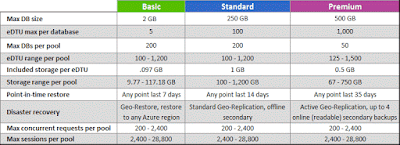| Service tier | Target workloads | Transactional Perf. Objective | SLA |
| Basic | Best suited for a small size database, supporting typically one single active operation at a given time. Examples include databases used for development or testing, or small scale infrequently used applications. | Reliability per hour | 99.99% |
| Standard | The go-to option for most cloud applications, supporting multiple concurrent queries. Examples include workgroup or web applications. | Reliability per minute | 99.99% |
| Premium | Designed for high transactional volume, supporting a large number of concurrent users and requiring the highest level of business continuity capabilities. Examples are databases supporting mission critical applications. | Reliability per second | 99.99% |
| BCDR option | Basic tier | Standard tier | Premium tier |
| Point In Time Restore | Any restore point within 7 days | Any restore point within 14 days | Any restore point within 35 days |
| Geo-Restore | ERT < 12h RPO < 1h | ERT < 12h RPO < 1h | ERT < 12h RPO < 1h |
| Standard Geo-Replication | Not included | ERT < 30s RPO < 5s | ERT < 30s RPO < 5s |
| Active Geo-Replication | Not included | Not included | ERT < 30s RPO < 5s |
Description of the terms:
• Disaster recovery (DR): a process of restoring the normal business function of the application
• Point in time restore: the ability to restore the database to a point in time in the past (within the backup retention period) in order to recover from data corruption caused by a human mistake or programmatic error
• Estimated Recovery Time (ERT): The estimated duration for the database to be fully functional after a restore/failover request.
• Recovery Point Objective (RPO): The amount of most recent data changes (time interval) the application could lose after recovery.
How is Standard Geo-replication different from Active Geo-replication?
First of all, standard geo-replication is built on the same technology as active geo-replication but is optimized for applications that use geo-replication only to protect the application from regional failures. The following list shows how standard geo-replication is different from active geo-replication:
1.Only one secondary database can be created in a Microsoft defined “DR paired” Azure region. The list of the DR pairs can be found here.
2.The secondary is visible in the master database but cannot be directly connected to until failover is completed (offline secondary).
3.The secondary database is charged at a discounted rate as it is not readable (offline).
As a result some scenarios you could enable using active geo-replication are not possible with the standard geo-replication. The following table summarizes this delta
| Scenario | Standard Geo-replication | Active Geo-replication |
| Regional disaster | Yes | Yes |
| DR drill | Yes | Yes |
| Online application upgrade | No | Yes |
| Online application relocation | No | Yes |
| Read load balancing | No | Yes |


Completely agree... It is important to pick right BCDR service for your business. Thanks for sharing valuable information.
ReplyDelete